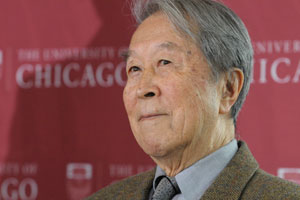Chicago In the News
The Chronicle’s biweekly column Chicago In the News offers a digest of commentary and quotations by a few of the University faculty members, students and alumni who have been headlining the news in recent weeks. Chicago faculty members are some of the most frequently quoted experts, so space allows publishing references to only selected examples. To read many of the full newspaper articles mentioned in this column, visit the University News Office Web site: http://news.uchicago.edu.
 Yoichiro Nambu’s |
|
Nobelist earns worldwide fame
Yoichiro Nambu’s reception of the 2008 Nobel Prize in Physics made international headlines Tuesday, Oct. 7. Nambu, the Harry Pratt Judson Distinguished Service Professor Emeritus in Physics and the Enrico Fermi Institute, shared the prize with two Japanese physicists. The Nobel Foundation credited Nambu, one of the leading figures in the development of modern particle physics, with “the discovery of the mechanism of spontaneous broken symmetry in subatomic physics.” The story was reported in all of the major American metropolitan papers, as well as international outlets including the Guardian, Star and the BBC, (Great Britain), AFP (France), Daily Yomiui (Japan), People’s Daily (China), the Stockholm News, the Scotsman and Al Jazeera.
Shades of grey in polling
Michael Dawson, the John D. MacArthur Distinguished Service Professor in Political Science and the College, believes the upcoming election will be the true test of whether race skews polling data. An article in the Sunday, Oct. 12 Washington Post debated the prevalence of the “Bradley effect,” which holds that whites voice support for an African-American candidate in polling then vote for the white opponent. While most experts don’t believe the phenomenon will affect this year’s presidential race, Dawson is not one of them: “I’m one of those who believe the Bradley effect is alive and well.” A December 2007 Gallup poll found that 5 percent of white respondents said they would not vote for a black candidate, compared to 58 percent in 1958. Dawson is skeptical of whites’ willingness to vote for a black candidate in this year’s high-profile election but says of the effect, “if we don’t see it now, then it’s gone.” Dawson also appeared on ABC News.
Extending scholarly pursuits
An article in the Sunday, Oct. 12 Chicago Sun-Times examined the Division of the Humanities’ collaboration with about 100 institutions to develop software and technology to help researchers, scholars and computer scientists in their pursuits. Dubbed Project Bamboo, the 18-month project has spawned workshops where professors’ and researchers’ concerns are translated into a plan. Translating medieval Chinese texts or researching silent movies were cited examples. “Computers are already good at finding patterns, particularly in text,” said Arno Bosse, Senior Director for Technology in the Humanities Division. “It won’t replace the researchers, but rather act as a powerful extension to his or her abilities.” Chad Kainz, Senior Director of NSIT Academic Technologies, also was quoted.
Here’s to your health—and wallet
Jon Gabel, Senior Fellow in Health & Policy Evaluation at the National Opinion Research Center at the University, was quoted in a Tuesday, Oct. 14 Washington Post article about employers shifting health care costs to workers. The article holds that many large companies are adding financial incentives to their wellness and disease management efforts. A recent Kaiser Family Foundation study showed that few employers pay people to take part in their programs—about 35 percent. Cash incentives, combined with lifestyle and health risk assessments, can bring up to $3 in savings for every dollar spent over three years. Gabel said shifting costs to workers isn’t always the best answer. “It cuts health spending both for effective and ineffective care.”
Modifying the bailout plan
Raghuram Rajan, the Eric J. Gleacher Distinguished Service Professor of Finance in the Graduate School of Business, commented on the United States government’s recapitalization plan in a Tuesday, Oct. 14 story in the Globe and Mail. A recent modified plan of the government’s $700 billion rescue package aimed to get capital into the hands of the bankers quickly, reducing overpayment for distressed, mortgage-backed assets. “They were trying to do the recapitalization and clean up balance sheets at one go,” said Rajan, a former chief economist at the International Monetary Fund. “It was basically confusing a lot of things.” Rajan also was quoted in The New York Times and Newsweek and the Associated Press and Reuters news wires.
Doctors: Rickets on the rise
A Tuesday, Oct. 14 article in the Chicago Tribune examined the rising incidences of vitamin D deficiency among American children. Reported cases of rickets, a vitamin D deficiency, are up from 65 reported cases between 1975 and 1985 to 166 cases between 1986 and 2003. Rickets causes a softening and weakening of bones and can bring about bowlegs or a curved spine. Children are now recommended to get 400 international units of vitamin D daily, meaning many children will need to take a supplement. “Kids need four glasses of milk to meet the recommendations. Most kids are not drinking that much,” said Joel Schwab, Associate Professor in Pediatrics. “I think supplementation is the only way to guarantee that kids are getting enough vitamin D.”
Teaching art of preservation
The Oriental Institute will join the Field Museum in teaching Iraqi scientists artifact-preservation techniques, following an announcement by first lady Laura Bush on Thursday, Oct. 16. The $14 million Iraq Culture Project aims to preserve the history of Iraq and its National Museum, which was looted amid the United States-led invasion of 2003. The project will establish an institute in the northern Iraqi city of Erbil to train 45 Iraqis of new methods of preservation. A Friday, Oct. 17 Chicago Tribune article quoted Gil Stein, Director of the Oriental Institute. The story also appeared in the Chicago Sun-Times.
![[Chronicle]](/images/sidebar_header_oct06.gif)